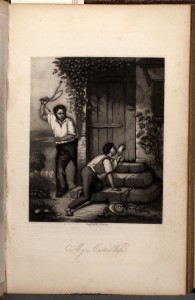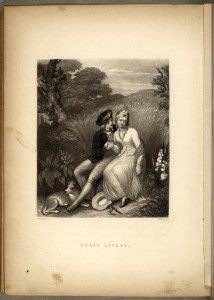The American Antiquarian Society’s Graphic Arts department is currently in the early stages of a two-year long project entitled Prints in the Parlor. The project is funded by a grant from the National Endowment of the Humanities and focuses on cataloging engravings  which would have appeared in the American parlor from 1820 to about 1876. Large, single sheet engravings depicting politicians, patriotic events, moral lessons, and religious themes are included in the grant and are being digitized as they are added to our online catalog. I promise a later post with more on these wonderful prints, but today’s blog posting is focused on the second portion of the grant, the engravings which appear in gift books.
which would have appeared in the American parlor from 1820 to about 1876. Large, single sheet engravings depicting politicians, patriotic events, moral lessons, and religious themes are included in the grant and are being digitized as they are added to our online catalog. I promise a later post with more on these wonderful prints, but today’s blog posting is focused on the second portion of the grant, the engravings which appear in gift books.
Gift books were published in the United States mostly before 1870, with the height of their popularity occurring in the 1840s and ‘50s. Based on a British tradition, the elegantly bound books contain poetry, prose, and illustrations and were intended to be read at home in the parlor. They were marketed for the holiday trade, and often came out in November with titles such as the Christmas Gift from Fairyland or The Friendship’s Offering and Winter’s Wreath. There are several good bibliographies of American gift books (see below) that break down the authors, texts, and titles of the illustrations, but no resource has yet provided the level of access to the illustrations that the Society is undertaking. Each engraved image in each gift book is being cataloged individually into our online catalog and will be searchable by key words in the description, assigned subject headings, and also by engraver and artist. The images are also being digitized. Our hope is to open up these illustrations to researchers and to add them to the ongoing conversation around nineteenth century visual culture.
 At the six month mark of the project we find that we are making some interesting discoveries. Christine Graham-Ward, our intrepid cataloger, has worked her way through about 188 volumes and cataloged 1,010 images. The challenge comes from keeping track of duplicates and repeated images, of which there are many. This will come as no surprise to scholars who are interested in the history of the book and who understand the complex nature of these objects. For the rest of us, however, it has been enlightening to realize that many gift book plates were reused over decades. Yes, you read that correctly, decades! The same image of two pretty girls first appears in 1828 and then re-appears multiple times in various volumes through 1849 – that’s a twenty one year time span! Some images do seem to be specific to the volume in which they appear, such as the view of a Hindu temple which appears in the Oriental Annual (N.Y. 1851) and nowhere else (yet!).
At the six month mark of the project we find that we are making some interesting discoveries. Christine Graham-Ward, our intrepid cataloger, has worked her way through about 188 volumes and cataloged 1,010 images. The challenge comes from keeping track of duplicates and repeated images, of which there are many. This will come as no surprise to scholars who are interested in the history of the book and who understand the complex nature of these objects. For the rest of us, however, it has been enlightening to realize that many gift book plates were reused over decades. Yes, you read that correctly, decades! The same image of two pretty girls first appears in 1828 and then re-appears multiple times in various volumes through 1849 – that’s a twenty one year time span! Some images do seem to be specific to the volume in which they appear, such as the view of a Hindu temple which appears in the Oriental Annual (N.Y. 1851) and nowhere else (yet!).  Others are, as my eleven-year-old would say, completely random. The odd image, “My Master’s Wife” appears in the Forget-me-not, for 1850 and has absolutely no relation to any of the texts or poems in the volume. Often, an engraving gets re-titled to better fit with the text of the volume. This is the case with “The Harvest,” an illustration which first appears in 1848 showing a young couple in a country setting. In three variant incarnations, the title on the plate has been rubbed out and replaced, first with “Rural Lovers” (1852, 1855), then with “The Lovers” (1855), and finally with “Highland Mary” (1856).
Others are, as my eleven-year-old would say, completely random. The odd image, “My Master’s Wife” appears in the Forget-me-not, for 1850 and has absolutely no relation to any of the texts or poems in the volume. Often, an engraving gets re-titled to better fit with the text of the volume. This is the case with “The Harvest,” an illustration which first appears in 1848 showing a young couple in a country setting. In three variant incarnations, the title on the plate has been rubbed out and replaced, first with “Rural Lovers” (1852, 1855), then with “The Lovers” (1855), and finally with “Highland Mary” (1856).  I should remind you, we are only one quarter of the way through our holdings – there could be more alternate titles to come!
I should remind you, we are only one quarter of the way through our holdings – there could be more alternate titles to come!
So when you are sitting at home figuring out your Times crossword, or dealing with the latest evil sudoku concocted by Will Shortz, keep in mind the ever-changing visual puzzle that Christine must grapple with daily as she moves through the gift books and their plates. Is this the picture of the woman leaning out the window that she saw back in September? Is this the same image of children outside of a cottage and it just has a different title? What about this lady wearing a turban? What were these crazy gift book publishers thinking? Well, at least we can answer that last one – as the book history scholar (and current AAS Fellow) Michael Winship has often said, the publisher is always trying to find a way to separate his customers from their money! Using attractive images over and over in gift books was apparently an affordable strategy (as the publishers could pass plates around amongst themselves or reuse them over the years) that allowed the publisher to quickly repackage text and plates to sell to the demanding holiday crowd.
We’ll have later posts on this project as we move forward. As we learn more about these complex volumes, we may have a new take on gift book illustration to share. We welcome comments!
Further Reading:
Faxon, Frederick W. Literary Annuals and Gift Books: A Bibliography, 1823-1903. 1912. Reprint. Pinner, U.K.: Private Libraries Association, 1973.
Kirkham, E. Bruce, and John W. Fink, comps. Indices to American Literary Annuals and Gift Books, 1825-1865. New Haven, Conn.: Research Publications, 1975. Includes full tables of contents and lists of illustrations from the almost five hundred titles listed in Thompson’s bibliography, with author, engraver, title, and other indexes.
Thompson, Ralph. American Literary Annuals & Gift Books, 1825-1865. 1936. Reprint. Hamden, Conn.: Archon Books, 1967.

Does this project also include indexing engravings of author portraits that were used as frontispieces?
We are indeed cataloguing all engraved frontispieces in the gift book collection. Often these are purely decorative images, but we have seen a few portraits of an editor or author related to the gift book in question. However, we are unable to include images that are lithographed or wood engraved, as those fall outside of the focus of the grant, which is intaglio engraving.
It’s an amazing coincidence, but the Henry Inman that you illustrate, “The Sisters,” engrved by Asher B. Durand, represent Catherine and Emma Livingston, two of the children of Henry Livingston of Claverack. Inman painted six of their children–they eventually had eight–the painting created in 1827 and shown at the National Academy in 1828–the very year their father died. The picture was just on the art market and two weeks ago was purchased by a major collector for her newly built, superb home, not too far from the Livingston’s original mansion, now known as “Talavera,” though often called the Van Ness House–it was built by Judge Van Ness whose daughter, Ann Eliza, had married Henry Livingston. I know that the print appeared in two early gift books, The Atlantic Souvenir for 1829 and El Alguinaldo for 1830, the only Spanish-language one published in the Unied States. Where else?
Thank you for this great information! The image of the Livingstone girls also appears in The Lily (New York, 1838 and again in 1840), The Flowerette (New York, 1842) and The Forget me Not (New York, 1849). Remember, we are only about one quarter of the way through the grant, so the image could also appear in more gift books — we will update our on-line catalogue as we find any additional occurrences. You can locate the full record for the plate in our on-line catalogue by searching on the title “Sisters.”
Dear Lauren–
And thank you for your information! Helps greatly. But I need your assistance. Gigi sent me the website for the gift books:
http://172.18.1.34/cgi-bin/Pwebrecon.cgi?DB=local&PAGE=First
But I couldn’t open this on either AOL or InternetExplorer. And looking for Henry Inman in the Gift Books, while i could find him in some documents–the 64 letters relating to Childs & Inman, I couldn’t find his reproductions in the Gift Books. Can you help me here? Guide me through the AAS website? Maybe by telephone? 2128601181–if you have the time.
Bill Gerdts
Hi Lauren — I’m sure you’ve seen this, but just in cast you haven’t…
http://www.orgs.muohio.edu/anthologies/FMN/Index.htm
I ran across it several years ago while researching a gift book image that appears on a china pattern I collect.
Great project you’re doing there — I look forward to reading about your new finds!